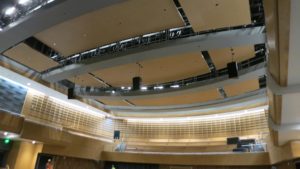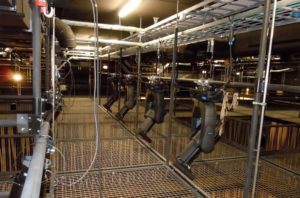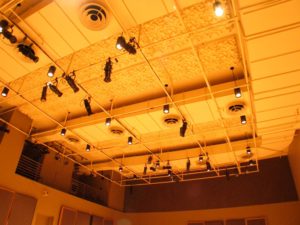Rigging in a Music Performance Studio
“What kind of overhead rigging will a music performance studio need?”
Whenever a theatre consultant collaborates with an architect and a user to design a venue, one of the questions that quickly arises is: How will this venue be used? This question applies to the types of performances the venue needs to host, but just as critically to the frequency with which the intended performances take place, the level of production value, and the amount of production staff that may or may not be available to change over the venue between events.
Here is an example. In discussions about a music performance studio to be housed within a new facility being built for a local music school, the design team had to address these very questions. The studio was intended to be used for small unamplified chamber music performed by students aged 6 to 18 and their instructors. The audience capacity needed to be as high as 75. The studio would also host lectures and small video presentations.
The architect and the client wanted the relationship of the loose seating and the stage to be flexible to allow the space to be set up in a variety of configurations. On a good day, the venue might have a technical staff person available to help set up a projector and screen, adjust loudspeakers, focus some lighting fixtures, and possibly rearrange seats or potentially a stage platform on the flat floor. The necessary production infrastructure and equipment needed to be easily accessible and easily adjustable for this minimal crew with limited time.
In this project context, a theatre consultant would reasonably estimate the users would need to hang a complement of production lighting fixtures, loudspeakers, some microphones, and a projection screen at or near the ceiling. Because the location of the seating and stage would change for different events up to 3-4 times per week, the production equipment also had to be able to shift its focus. Production lighting fixtures and loudspeakers had to provide even coverage to multiple areas within the flat floor venue and be able to shift their focus easily when the room layout changed. Perhaps the user could hang a general-purpose repertory lighting plot and loudspeaker layout to cover a few primary usage configurations, thereby minimizing changeover time. However, in such a situation the user could still reasonably expect easy ceiling access to make minor adjustments to the production equipment.
To determine a rigging approach to this studio, the theatre consultant might ask a few more questions: Is the volume of the venue such that we could integrate catwalks into the ceiling, perhaps above architecturally finished ceiling panels? Is the aesthetic of the venue such that a pipe grid or tension wire grid would be acceptable for hanging production equipment? In conjunction, could a ladder or rolling personnel lift be easily deployed by a technician to access a pipe grid from below? Would mechanized battens or trusses be appropriate or helpful? What are the budget considerations? Here are four technical solutions that might be considered:
Pipe grids can be an inexpensive way to provide a broad ceiling plane to mount production lighting fixtures, loudspeakers, masking, or minor scenic elements. As a technical solution, access to a pipe grid from below is required but requires that the floor be free of seats or platforms beneath the location in need of access. This expectation might be fine during a load-in but could be more challenging if seating and staging for an event are already set up. Additionally, if a pipe grid is higher than 25 to 30 feet above the floor, access from below can start to be uncomfortable for technicians and excessively time consuming. Ladders and personnel lifts also require nearby storage space.
Catwalks are a great way to provide technical access lanes at ceiling level allowing technicians to reach and focus production lighting fixtures, adjust minor rigging components, etc. Coordination must be undertaken to ensure catwalks are designed in the correct locations and with consideration for production necessities.

Catwalks at the ceiling of a concert hall with architecturally integrated panels beneath (shown in grey), and coordinated between adjustable acoustic ceiling reflectors.
Mechanized rigging is another option to consider. While generally more costly, mechanized rigging has its place, sometimes in the form of deployable pipe battens or trusses, or larger panelized sections of pipe grid or truss. To adjust non-mechanized lighting fixtures, the mechanized pipe or truss needs to be lowered to a level accessible by technicians, or reached from a lift like with a pipe grid. Lowering the rigging will add time to a light focusing session if shutter cuts need to be finely adjusted and the mechanized pipe needs to be flown in repeatedly to make such adjustments, giving us the term “bounce focusing.” Precise shutter cuts are generally less critical for non-dramatic performance venues where music is the dominant art form instead of theatre. These systems require a higher level of training for safe operation. Users also need to be aware of the increased maintenance requirements with a mechanized rigging system, at a minimum requiring regular inspections by a qualified professional.

Tension wire grid panel as walking surface, production lighting is able to shoot through to performance area.
Tension Wire Grids are another approach that can provide access at or near a ceiling. Steel framed panels woven with wire rope create a somewhat bouncy but still walkable surface that can be arrayed at the ceiling of a venue to allow technicians to access overhead lighting and rigging locations. Sometimes, slots are designed in between these panels to allow users to rig through the plane of the grid. Horizontal lighting pipes are typically laid out above the grid walking surface at waist height providing a position to mount production lighting fixtures. While providing excellent access, these systems do have their drawbacks, including the aesthetic look of the tension wire grid panels from below, which may be too industrial for many finished venues. Further, during a performance, when production lighting fixtures are shining through the tension wire panels, patrons are treated to a secondary “light show” as the tension wire grid is intensely illuminated in small elliptical areas by the nearby production lighting.
When designing hanging opportunities for production equipment and overhead technician access in a studio venue whose primary function is the performance of unamplified music, coordination with the project’s acoustician is essential. The acoustician may wish to locate acoustic reflectors at the ceiling to provide musicians with a nearby overhead reflective surface and direct early sound reflections to the audience. The layout of any opaque acoustic reflectors below a tension wire grid, for example, would need to be coordinated with the desired production lighting angles.
These are just a few options to consider, each with their own advantages and drawbacks. The best solution for a venue might involve one of these approaches or a customized mix of solutions for overhead rigging. When thinking about or designing different kinds of performance studios be sure to consider the type of overhead access that best serves the needs of the user.
By Michael Parrella, ASTC
Disclaimer: Any views or opinions expressed in this article are solely those of the author and do not necessarily represent those of the American Society of Theatre Consultants. This article is for general information only and should not be substituted for specific advice from a Theatre Consultant, Code Consultant, or Design Professional, and may not be suitable for all situations nor in all locations.



